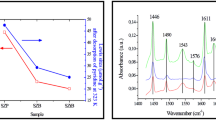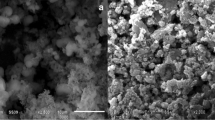Abstract
The catalytic efficiency of palladium supported sulfated zirconia catalysts in the isomerization of n-butane to isobutane has been studied in relation to the effects of the active site features (redox and acidic). By using the XRD, UV-DRS, and N2 adsorption methods, the structural and textural changes in the synthesized catalyst were investigated. H2-TPR was used to assess the sulfate species' type and distribution on the surface of the catalysts as well as their redox behavior. The n-butylamine titration method, NH3-TPD, and Py-FT-IR spectroscopy were used to characterize the nature/strength and kinds of acid sites. The CO-TPD was used to determine the kind of active sites. The outcomes showed that the Fe promoter in a sulfated catalyst has a major impact on the activity of n-butane isomerization. Comparing Fe–Mn and Fe alone promoted catalysts to a combination of Fe–Cr and Fe–V promoters, the activity was further increased. The findings of the characterization showed that the nature of the metal dopants influences the surface characteristics of the catalysts (their redox nature and the strength of their surface adsorption), which may be related to their ionic charge or electron density. The metal–metal synergy between the metal dopant and the zirconia matrix, which helped to improve the catalysts performance for n-butane isomerization, is primarily responsible for the active sites' adsorption capacity and reducibility. The findings of the characterization showed that the nature of metal dopants governs the surface properties of the catalysts (redox nature and surface adsorption strength), which could be related to the electron density or ionic charge. The metal–metal synergy between the metal dopant and the zirconia matrix is primarily responsible for the active sites' adsorption capacity and reducibility, which contributed to improve the catalysts' performance for n-butane isomerization. In addition, for the purpose of optimizing the Fe–V promoted sulfated zirconia catalyst, catalyst characteristics (acidity) can be adjusted by the catalyst synthesis conditions.











Similar content being viewed by others
Data availability
The data is available.
References
Fahim MA, Alahhaf TA, Elkilani AS (2010) Fundamentals of Petroleum Refining. Elsevier, Amsterdam
Valavarasu G, Sairam B (2013) Light naphtha isomerization process: a review. Pet Sci Technol 31:580–595. https://doi.org/10.1080/10916466.2010.504931
Dhar A, Vekariya RL, Bhadja P (2018) n-Alkane isomerization by catalysis—a method of industrial importance: an overview. Cogent Chem 4:154686–154705. https://doi.org/10.1080/23312009.2018.1514686
Yan GX, Wang A, Wachs IE, Baltrusaitis J (2019) Critical review on the active site structure of sulfated zirconia catalysts and prospects in fuel production. Appl Catal A 572:210–225. https://doi.org/10.1016/j.apcata.2018.12.012
Hidalgo JM, Zbuzek M, Cerny R, Jisa P (2014) Current uses and trends in catalytic isomerization, alkylation and etherification processes to improve gasoline quality. Cent Eur J Chem 12(1):1–13. https://doi.org/10.2478/s11532-013-0354-9
Urzhuntsev GA, Ovchinnikova EV, Chumachenko VA, Yashnik SA, Zaikovsky VI, Echevsky GV (2014) Isomerization of n-butane over Pd–SO4/ZrO2 catalyst: prospects for commercial application. Chem Eng J 238:148–156. https://doi.org/10.1016/j.cej.2013.08.092
Liu N, Ma Z, Wang S, Shi L, Hu X, Meng X (2020) Deactivation behavior in isomerization of n-hexane. Fuel 262:116566–116573. https://doi.org/10.1016/j.fuel.2019.116566
Ma Z, Meng X, Liu N, Shi L (2018) Pd–Ni doped sulfated zirconia: study of hydrogen spillover and isomerization of N-hexane. Mol Catal 449:114–121. https://doi.org/10.1016/j.mcat.2018.02.003
Kumar A, Rajendra Prasad B, Singhal S, Shilpi A, Raj Tripathi A (2018) Synthesis and characterization of zirconia-based catalyst for the isomerization of n-hexane. Chem Eng Commun 205:92–101. https://doi.org/10.1080/00986445.2017.1373103
Bikmetova LI, Kazantsev KV, Zatolokina EV, Dzhikiya OV, Smolikov MD, Belyi AS (2020) Sulfated zirconia catalysts supported on alumina for hexane isomerization. AIP Conf Proc 2301:1. https://doi.org/10.1063/5.0032862
Wang P, Zhang M, Zhang W, Yang Ch, Li Ch (2017) Isomerization of n-Butane over SO42−/Al2O3−ZrO2 in a circulated fluidized bed reactor: prospects for commercial application. Ind Eng Chem Res 56:8456–8464. https://doi.org/10.1021/acs.iecr.7b01858
Ebitani K, Konno H, Tanaka T, Hattori H (1992) In-situ XPS study of zirconium oxide promoted by platinum and sulfate ion. J Catal 135:60–67. https://doi.org/10.1016/0021-9517(92)90268-M
Lglesia E, Soled SL, Kramer GM (1993) Isomerization of alkanes on sulfated zirconia: promotion by Pt and by adamantyl hydride transfer species. J Catal 144:238–253. https://doi.org/10.1006/jcat.1993.1327
Belskaya OB, Danilova IG, Kazakov MO, Gulyaeva TI, Kibis LS, Boronin AI, Lavrenov AV, Likholobova VA (2010) Investigation of active metal species formation in Pd-promoted sulfated zirconia isomerization catalyst. Appl Catal A 387:5–12. https://doi.org/10.1016/j.apcata.2010.07.052
Umansky BS, Bhinde DV, Hsu CY Hydrocarbon isomerization using solid super acid catalysts comprising platinum metal. Sun Company, Inc. (R&M), US Patent 5516964 (A).
Cheung TK, Ditri JL, Gates BC (1995) Low-temperature superacid catalysis: reactions of n-butane catalyzed by iron- and manganese-promoted sulfated zirconia. J Catal 151:464–466. https://doi.org/10.1006/jcat.1995.1050
Jentoft FC, Hahn A, Kröhnert J, Lorenz G, Jentoft RE, Ressler T, Wild U, Schlögl R, Häßner C, Köhler K (2004) Incorporation of manganese and iron into the zirconia lattice in promoted sulfated zirconia catalysts. J Catal 224:124–137. https://doi.org/10.1016/j.jcat.2004.02.012
Garcia EA, Rueda EH, Rouco AJ (2001) Sulfated zirconia catalysts promoted with Fe and Mn:Mn effect in the Fe dispersion. Appl Catal A 210:363–370. https://doi.org/10.1016/S0926-860X(00)00827-9
Miao C, Hua W, Chen J, Gao Z (1996) Studies on SO42− promoted mixed oxide superacids. Catal Lett 37:187–191. https://doi.org/10.1007/BF00807752
Mogica-Betancourt JC, López-Benítez A, Montiel-López JR, Massin L, Aouine M, Vrinat M, Berhault G, Guevara-Lara A (2014) Interaction effects of nickel polyoxotungstate with the Al2O3–MgO support for application in dibenzothiophene hydrodesulfurization. J Catal 313:9–23. https://doi.org/10.1016/j.jcat.2014.02.009
Clearfield A, Serrette GPD, Khazi-Syed AH (1994) Nature of hydrous zirconia and sulfated hydrous zirconia. Catal Today 20:295–312. https://doi.org/10.1016/0920-5861(94)80008-1
Song Y, Tian J, Ye Y, Jin Y, Zhou X, Wang JA, Xu L (2013) Effects of calcination temperature and water-washing treatment on n-hexane hydroisomerization behavior of Pt-promoted sulfated zirconia based catalysts. Catal Today 212:108–114. https://doi.org/10.1016/j.cattod.2012.07.024
Alhassan FH, Rashid U, Sadiq Al-Qubaisi M, Rasedee A, Taufiq-Yap YH (2014) The effect of sulfate contents on the surface properties of iron–manganese doped sulfated zirconia catalysts. Powder Technol 253:809–813. https://doi.org/10.1016/j.powtec.2013.12.045
Akinnawo CA, Bingwa N, Meijboom R (2021) Metal-doped mesoporous ZrO2 catalyzed chemoselective synthesis of allylic alcohols from Meerwein–Ponndorf–Verley reduction of a, b-unsaturated aldehydes. New J Chem 45:7878–7892. https://doi.org/10.1039/D1NJ00936B
Wiwattanapongpan J, Mekasuwandumrong O, Chaisuk C, Praserthdam P (2007) Effect of dopants on the properties of metal-doped zirconia prepared by the glycothermal method. Ceram Int 33:1469–1473. https://doi.org/10.1016/j.ceramint.2006.05.014
Tabora JE, Davis RJ (1995) Structure of Fe, Mn-promoted sulfated zirconia catalyst by X-ray and IR absorption spectroscopies. J Chem Soc Faraday Trans 91(12):1825–1833. https://doi.org/10.1039/FT9959101825
Srinivasan R, Keogh RA, Davis BH (1995) Activation and characterization of FeMnSO42−ZrO2 catalysts. Appl Catal A 130:135–155. https://doi.org/10.1016/0926-860X(95)00127-1
Hino M, Arata K (1996) Preparation of superacid of iron-supported zirconia for reaction of butane to isobutane. Catal Lett 34:125–128. https://doi.org/10.1007/BF00807607
Tanaka T, Yamamoto T, Kohno Y, Yoshida T, Yoshida S (1999) Application of XANES spectra to supported catalysts. Jpn J Appl Phys 38:30–35. https://doi.org/10.7567/JJAPS.38S1.30
Yamamoto T, Tanaka T, Takenaka S, Yoshida S, Onari T, Takahashi Y, Kosaka T, Hasegawa S, Kudo M (1999) Structural analysis of iron and manganese species in iron- and manganese-promoted sulfated zirconia. J Phys Chem B 103:2385–2393. https://doi.org/10.1021/jp984378j
Srinivasan R, Keogh RA, Milburn DR, Davis BH (1995) Sulfated zirconia catalysts: characterization by TGA/DTA mass spectrometry. J Catal 153:123–130. https://doi.org/10.1006/jcat.1995.1114
Prasetyoko D, Ramli Z, Endud S, Nur H (2005) TS-1 loaded with sulfated zirconia as bifunctional oxidative and acidic catalyst for transformation of 1-octene to 1,2-octanediol. J Mol Catal A 241:118–125. https://doi.org/10.1016/j.molcata.2005.06.070
Mohan Reddy K, Lingaiah N, Sai Prasad PS, Suryanarayana I (2006) Acidity constants of supported salts of heteropoly acids using a methodology related to the potentiometric mass titration technique. J Solution Chem 35(3):407–423. https://doi.org/10.1007/s10953-006-9025-1
Alaya MN, Rabah MA (2017) Preparation, characterization and catalytic activity of WO3 supported on sulfated tin oxide catalysts. Arab J Chem 10:S705–S718. https://doi.org/10.1016/j.arabjc.2012.11.012
Abo El-Yazeed WS, El-Hakam SA, Salama RS, Ibrahim AA, Ahmed AI (2022) Ag-PMA supported on MCM-41: surface acidity and catalytic activity. J Sol–Gel Sci Technol 102:387–399. https://doi.org/10.1007/s10971-022-05755-7
Zhao H, Jiang P, Dong Y, Huang M, Liu B (2014) A high-surface-area mesoporous sulfated nano-titania solid superacid catalyst with exposed (101) facets for esterification: facile preparation and catalytic performance, New. J Chem 38:4541–4548. https://doi.org/10.1039/C4NJ00494A
Viswanathan B, Gopalakrishnan R, Vetrivel R (1981) Temperature programmed desorption (TPD) of carbon monoxide from cobalt surfaces. React Kinet Catal Lett 18(1–2):209–212. https://doi.org/10.1007/BF02065165
Xia R, Zhang S, Ma X, Jiao F (2020) Surface-functionalized palladium catalysts for electrochemical CO2 reduction. J Mater Chem A 8:15884–15890. https://doi.org/10.1039/D0TA03427D
Millet JMM, Signoretto M, Bonville P (2000) Characterization of Fe-promoted sulfated zirconia catalysts used for the n-butane isomerization by XPS and Mössbauer spectroscopies. Catal Lett 64:135–140. https://doi.org/10.1023/A:1019003523926
Zhang A, Nakamura I, Aimoto K, Fujimoto K (1995) Isomerization of n-pentane and other light hydrocarbons on hybrid catalyst. Effect of hydrogen spillover. Ind Eng Chem Res 34:1074–1080. https://doi.org/10.1021/ie00043a008
Setiabudi HD, Jalil AA, Triwahyono S (2012) Ir/Pt-HZSM5 for n-pentane isomerization: effect of iridium loading on the properties and catalytic activity. J Catal 294:128–135. https://doi.org/10.1016/j.jcat.2012.07.012
Adeeva V, Lei GD, Sachtler WMH (1994) Isomenzation of 13C labeled butane over Fe, Mn promoted sulfated ZrO2 catalyst. Appl Catal A 118:L11–L15. https://doi.org/10.1016/0926-860X(94)80084-7
Lange FC, Cheung TK, Gates BC (1996) Manganese, iron, cobalt, nickel, and zinc as promoters of sulfated zirconia forn-butane isomerization. Catal Lett 41:95–99. https://doi.org/10.1007/BF00811719
Wang P, Zhang M, Zhang W, Yang C, Li C (2017) Consequence of heterogeneity of active sites for reactivity mechanism of n-butane isomerization over SO42−/ZrO2–Al2O3 catalyst. Appl Catal A 542:311–316. https://doi.org/10.1016/j.apcata.2017.06.005
Morterra C, Cerrato G, Emanuel C, Bolis V (1993) On the surface acidity of some sulfate-doped ZrO2 catalysts. J Catal 142:349–367. https://doi.org/10.1006/jcat.1993.1213
Acknowledgements
The authors appreciate the management's assistance in supporting the effort. We are also grateful for the project manager, Dr. Adel Al-Shafai, and the project participants, Mr. Srikant Badgandi and Mr. Faizal Benaskar. Additionally, I would like to thank Ms. A.D. Rosa and Mr. R. Ganeshan for characterizing the catalyst samples using the XRF and n-butylamine titration methods.
Author information
Authors and Affiliations
Contributions
Conceptualization: ND and PS; investigation: ND, UH and SH; validation: ND and PS; writing—original draft: ND; visualization: ND, PS, and SA-M; writing—review & editing: ND, VN and SA-M; supervision: VN. All of the authors discussed and commented on the manuscript.
Corresponding author
Ethics declarations
Conflict of interest
There are no conflicts to declare.
Additional information
Publisher's Note
Springer Nature remains neutral with regard to jurisdictional claims in published maps and institutional affiliations.
Rights and permissions
Springer Nature or its licensor (e.g. a society or other partner) holds exclusive rights to this article under a publishing agreement with the author(s) or other rightsholder(s); author self-archiving of the accepted manuscript version of this article is solely governed by the terms of such publishing agreement and applicable law.
About this article
Cite this article
Dhachapally, N., Sreekanth, P., Hasyagar, U. et al. Metal-promoted sulfated zirconia catalysts redox and acidic characteristics and their impact on n-butane isomerization. Reac Kinet Mech Cat 136, 1327–1355 (2023). https://doi.org/10.1007/s11144-023-02415-x
Received:
Accepted:
Published:
Issue Date:
DOI: https://doi.org/10.1007/s11144-023-02415-x




